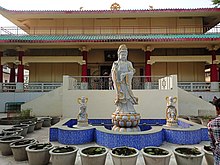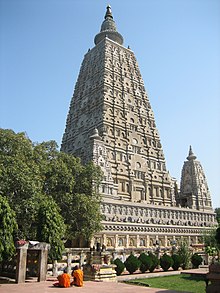Bodh Gaya
Bodh Gayā | |
|---|---|
Town | |
UTC+5:30 (IST) | |
| PIN | 824231 |
| Vehicle registration | BR-02 |
| |
Bodh Gayā is a religious site and place of pilgrimage associated with the
For Buddhists, Bodh Gaya is the most important of the main four pilgrimage sites related to the life of Gautama Buddha,[5] the other three being Kushinagar, Lumbini, and Sarnath. In 2002, Mahabodhi Temple, located in Bodh Gaya, became a UNESCO World Heritage Site.[6]
History
Buddha's Holy Sites |
 |


Bodh Gaya is considered to be the holiest site in Buddhism.[7] Known as Uruvela in the Buddha's time, it is situated by the bank of the Lilajan River. The first temple at the site was built by Maurya Emperor Ashoka.[8]
Traditionally, it is believed that the Buddha was born in 563 BC on the next Baisakhi purnima [second full moon in calendar years that do not themselves start during full moon] in Lumbini Nepal. As Siddhartha, he renounced his family at the age of 29 in 534 BC,

At this place, the Buddha was abandoned by the five men who had been his companions in his earlier austerities. All they saw was an ordinary man; they mocked his well-nourished appearance. "Here comes the mendicant Gautama," they said, "who has turned away from asceticism. He is certainly not worth our respect." When they reminded him of his former vows, the Buddha replied, "Austerities only confuse the mind. In the exhaustion and mental stupor to which they lead, one can no longer understand the ordinary things of life, still less the truth that lies beyond the senses. I have given up extremes of either luxury or asceticism. I have discovered the Middle Way." This is explained as the path which is neither easy (his former life as a rich prince) nor hard (living in austere conditions, practicing self-denial). Hearing this, the five ascetics became the Buddha's first disciples in Deer Park,
The disciples of Gautama began to visit the place during the full moon in the month of
The history of Bodh Gaya is documented by many inscriptions and pilgrimage accounts. Foremost among these are the accounts of the
During the period from the 11th to 13th centuries, Bodh Gaya was under the control of local chieftains known as the Pithipatis of Bodh Gaya who were responsible for the management of the region. One of their rulers, Acarya Buddhasena, has been recorded as making a grant to Sri Lankan monks near the Mahabodhi temple.[13]
Mahabodhi Temple

The complex, located about 110 kilometres from
contains the Mahabodhi Temple with theIn approximately 250 BCE, about 200 years after the Buddha attained Enlightenment, Emperor
Representations of this early temple are found at Sanchi, on the toraṇas of Stūpa I, dating from around 25 BCE, and on a relief carving from the stupa railing at Bhārhut, from the early Shunga period (c. 185 – c. 73 BCE).[15]
Other Buddhist temples

Kittisirimegha of Sri Lanka, a contemporary of Samudragupta, erected with his permission a Sanghārāma near the Mahabodhi Temple, chiefly for the use of the Singhalese monks who went to worship the Bodhi tree. The circumstances in connection with the Sanghārāma are given by Xuanzang (Beal, op. cit., 133ff) who gives a description of it as seen by himself. It was probably here that Buddhaghosa met the Elder Revata who persuaded him to come to Ceylon.
Several Buddhist temples and monasteries have been built by the people of Tibet, Mongolia, Nepal, Japan, Korea, Cambodia, Laos, Myanmar, Vietnam, Sikkim, Sri Lanka, Taiwan, Thailand, Bhutan and China in a wide area around the Mahabodhi Temple. These buildings reflect the architectural styles and decoration of their respective countries. The statue of the Buddha in the Chinese temple is 200 years old, and was brought from China. Japan's Nippon temple is shaped like a pagoda. The Myanmar (Burmese) temple is also pagoda-shaped and is reminiscent of Bagan. The Thai temple has a typical sloping, curved roof covered with golden tiles. Inside, the temple holds a massive bronze statue of the Buddha. Next to the Thai temple is a 25-metre statue of the Buddha within a garden which has existed for over 100 years.[citation needed]
- Sujata Stupa
Across the
The Great Buddha Statue
An 80-foot statue of the Buddha, known as The Great Buddha Statue is located in Bodhgaya. The unveiling and consecration of the Great Buddha Statue took place on 18 November 1989. The consecration ceremony was attended by the 14th Dalai Lama, who blessed the 25-meter statue, the first great Buddha ever built in the history of India.
Under the slogan "Spread Buddha's rays to the Whole World," Daijokyo [clarification needed] spent seven years on construction of the Great Buddha Statue, mobilizing 120,000 masons in total.
Mahabodhi Temple bombings
On 7 July 2013, at around 05:15, a low intensity
On 1 June 2018, a special National Investigation Agency (NIA) court of Patna sentenced five suspects in the case to life imprisonment.[24]
Demographics
As per the
Transportation
- Buses have been introduced by the
- A special caravan service called Wonder on Wheel, between Patna and Bodh Gaya, has been introduced by the Bihar Tourism Department.[27]
- Gaya Airport is situated 7 kilometres (4 mi) from Bodh Gaya and approximately 10 kilometres (6 mi) from Gaya Junction railway station.
- Bodhgaya has restricted the use of auto rickshaws, cars and buses to make the pilgrimage site more peaceful. A permit is required for the use of cars and buses, and the only taxi available is an electric rickshaw that is mostly noiseless.
Sister cities
Bodh Gaya has one official
 Nara Prefecture, Japan[28]
Nara Prefecture, Japan[28]
See also
- Cetiya
- Bodhgaya inscription of Mahanaman
- Sri Maha Bodhi
- Lumbini
- Sarnath
- Kusinagar
- Rajgir
- Bakraur
- Kurkihar hoard
- Buddhist pilgrimage
- Indian Institute of Management Bodh Gaya
References
- ^ "पत्रांक-213 : राजगीर क्षेत्रीय आयोजना क्षेत्र एवं बोधगया आयोजना क्षेत्र के सीमांकन एवं घोषणा" (PDF). Urban Development Housing Dept., Government of Bihar, Patna. 15 April 2015. Archived (PDF) from the original on 18 June 2015. Retrieved 18 June 2015.
- ^ Gopal, Madan (1991). K.S. Gautam (ed.). India through the ages. Publication Division, Ministry of Information and Broadcasting, Government of India. p. 176.
- ISSN 0002-7189.
- ISBN 9780199948239.
- ^ "Buddhist Pilgrimage". Asia. Archived from the original on 27 September 2018. Retrieved 14 December 2019.
- ^ a b "Decisions adopted by the 26th Session of the World Heritage Committee" (PDF). World Heritage Committee. p. 62. Archived (PDF) from the original on 28 February 2015. Retrieved 10 July 2006.
- ^ "Holy Sites of Buddhism: Bodh Gaya – Place of Enlightenment". buddhanet.net. Archived from the original on 1 September 2010. Retrieved 14 December 2019.
- ^ "Mahabodhi Temple Complex at Bodh Gaya". UNESCO World Heritage Centre. Archived from the original on 7 December 2019. Retrieved 14 December 2019.
- ^ Barua, Sukomal (2012). "Buddha Purnima". In Islam, Sirajul; Jamal, Ahmed A. (eds.). Banglapedia: National Encyclopedia of Bangladesh (Second ed.). Asiatic Society of Bangladesh. Archived from the original on 8 May 2016.
- ^ "Spectrum | Sundayobserver.lk – Sri Lanka". Sundayobserver.lk. 22 April 2012. Archived from the original on 13 October 2014. Retrieved 2 June 2014.
- ISBN 9781452266565. Archivedfrom the original on 12 March 2023. Retrieved 6 October 2018.
- ^ "A History of Bodh Gaya by Venerable S. Dhammika". Buddhanet.net. Archived from the original on 2 February 2014. Retrieved 2 June 2014.
- ISBN 9780861592289. Archivedfrom the original on 12 March 2023. Retrieved 16 November 2021.
- ^ "Information Dossier for nomination of Mahabodhi Temple Complex, Bodhgaya as a World Heritage Site". Government of India. p. 4. Archived from the original (PDF) on 10 February 2009. Retrieved 10 July 2006.
- ^ "Sowing the Seeds of the Lotus: A Journey to the Great Pilgrimage Sites of Buddhism, Part I" by John C. Huntington. Orientations, November 1985 pg 61
- ISBN 9788122309638. Archivedfrom the original on 12 March 2023. Retrieved 3 September 2018.
- ISBN 9781787011991. Archivedfrom the original on 12 March 2023. Retrieved 3 September 2018.
- ISBN 8129107384.
- ISBN 9781136320675. Archivedfrom the original on 12 March 2023. Retrieved 3 September 2018.
- ^ Tiwari, Deeptiman (6 November 2013). "Ranchi document helps NIA crack Bodh Gaya blast case". The Times of India. Archived from the original on 6 November 2013. Retrieved 6 November 2013.
- ^ Gaikwad, Rahi; Yadav Anumeha; Pandey Devesh (7 November 2013). "Patna terror cell behind Bodh Gaya strike too: NIA". The Hindu. Patna, Ranchi, New Delhi. Archived from the original on 9 November 2013. Retrieved 7 November 2013.
- ^ "Serial Blasts rock Mahabodhi temple in Bodha gaya: terror attack, Center says". The Times of India. 7 July 2013. Archived from the original on 9 July 2013. Retrieved 7 July 2013.
- ^ "Nine blasts in Bodh Gaya, 2 injured". The Hindu. 7 July 2013. Archived from the original on 10 July 2013. Retrieved 7 July 2013.
- ^ "Five sentenced to life imprisonment in Bodh Gaya serial blasts case". Headlines Today. Archived from the original on 6 August 2018. Retrieved 2 June 2018.
- ^ "Census of India 2001: Data from the 2001 Census, including cities, villages and towns (Provisional)". Census Commission of India. Archived from the original on 16 June 2004. Retrieved 1 November 2008.
- ^ "BSTDC halts AC Bus Services to Bodhgaya devoid of Passengers". Archived from the original on 9 August 2013. Retrieved 31 August 2013.
- ^ "Bihar launches Tourist Caravan Service called Wonder on Wheel". The Biharprabha News. Archived from the original on 1 May 2013.
- ^ "Japan visit: Nitish proposes sister-state pact between Nara and Bodh Gaya". hindustantimes.com. Hindustan Times. 22 February 2018. Archived from the original on 18 May 2019. Retrieved 8 April 2020.
Bibliography
- Kinnard, Jacob N. (1998). When Is The Buddha Not the Buddha? The Hindu/Buddhist Battle over Bodhgayā and Its Buddha Image. Journal of the American Academy of Religion 66 (4), 817–839
- Geary, David; Sayers, Matthew R; Amar, Abhishek Singh (2012). Cross-disciplinary perspectives on a contested Buddhist site: Bodh Gaya jataka. London, New York: Routledge
External links
- Detailed history of Bodhgaya by Ven. S. Dhammika.
- Bihar state tourism development corporation (BSTDC) Archived 4 January 2007 at the Wayback Machine
- Places to Visit in Bodh Gaya
- Photos of Mahabodhi Temple & Bodhgaya
- Description of Bodhgaya by the Chinese pilgrim monk Faxian (399-414 AC)[dead link]
- Bodhgaya Map
